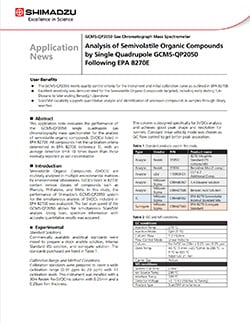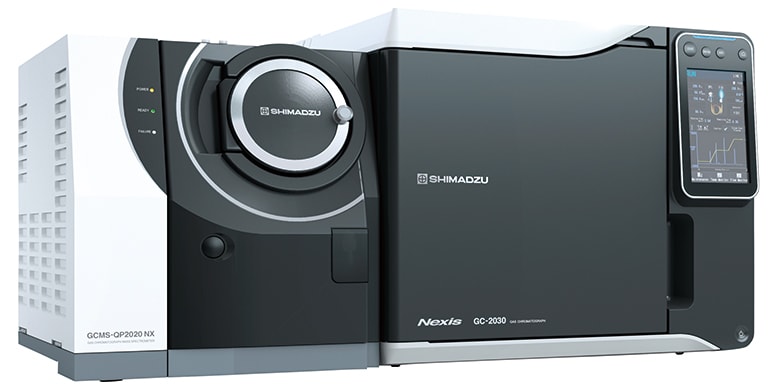VOCs & SVOCs in Wastewater and Recycled Water
Volatile Organic Compounds (VOCs) and Semivolatile Organic Compounds (SVOCs) are regulated in wastewater under the Clean Water Act in the United States; similar regulations are in place across the globe to minimize the presence of these chemicals in water. EPA has published standardized methods for the analysis of these compounds by gas chromatography mass spectrometry (GCMS). Most methods published by EPA require the use of GCMS Single Quadrupole for this analysis (EPA 624, EPA 625). However, the latest versions from EPA 8260 (8260D) and EPA 8270 (8270E) introduced the use of GCMS Triple Quadrupole.
Applications
Analysis of Semivolatile Organic Compounds by Single Quadrupole GCMS-QP2050 Following EPA 8270E
This application note evaluates the performance of the GCMS-QP2050 single quadrupole gas chromatography mass spectrometer for the analysis of semivolatile organic compounds (SVOCs) listed in EPA 8270E. All compounds met the calibration criteria determined in EPA 8270E (reference 1), with an average detection limit 10 times lower than those normally reported as vial concentration.
A Guide to the Novel Shimadzu GC-MS BFB Tuning for the Analysis of Volatile Organic Compounds in Environmental Samples
The Environmental Protection Agency (EPA) establishes strict BFB tuning criteria to ensure the quality of the results when analyzing volatile compounds. Due to many challenges inherent to GC-MS Purge and Trap instruments required for this analysis, several GC-MS instruments have difficulties in passing the required US EPA BFB tuning criteria or remaining stable over prolonged operations period. In this study, the performance of a novel BFB tuning algorithm was demonstrated on the latest Shimadzu GCMS-QP2020 NX. The demonstration study consisted of two phases that comprised 1) evaluating the BFB tune and 2) testing the stability of internal standards and surrogates for EPA methods 524.2 and 624/8260. The results illustrate that the BFB spectra was able to pass all EPA requirements of methods 524.2 and 624/8260 criteria for the analysis of at least 1407 samples for over 4 months. Moreover, these results confirm that the novel tuning algorithm used with the GCMS-QP2020 NX is a robust tool for performing EPA methods 524.2 and 624/8260.
Performance Demonstration of a Modern GC-MS Instrument and Novel BFB tune for Analysis of Volatile Compounds by EPA Method 624.1 and 8260C
With global population growth and demand for safe water, there is an increased need for monitoring pollutants in surface and groundwater as well as industrial wastewater discharges. As a result, there is growing demand for high-sensitivity state-of-the art instrumentation to meet and exceed limits set by new environmental regulations. In this study, the latest released Shimadzu GCMS-QP2020 NX is evaluated to demonstrate whether its performance meets the stability and sensitivity criteria from EPA methods 624.1 and 8260C. Results demonstrated that this novel BFB tune met EPA method 624.1 and 8260C criteria for an extended period of operations. To assess sensitivity, MDLs were calculated at two individual concentrations. For method 624.1, MDLs calculated at 0.50 µg/L ranged from 0.07 to 0.40 µg/L, while at 1.00 µg/L they ranged from 0.09 to 0.50 µg/L. Regarding method 8260C, MDLs ranged from 0.07 to 0.40 µg/L and from 0.09 to 0.50 µg/L when standards were spiked at 0.5 and 1.00 µg/L, respectively. Overall, the study results illustrate that the GCMS-QP2020 NX meets the EPA detection limits requirement for both these methods.
Analysis of Semivolatile Compounds by GCMS-TQTM8040 NX Triple Quadrupole Mass Spectrometer by EPA 8270E
Semivolatile Organic Compounds (SVOCs) are currently regulated in multiple environmental matrices. Hence, environmental laboratories need to routinely analyze these contaminants. EPA 8270E is the first method published by the Environmental Protection Agency (EPA) allowing the use of GCMS Triple Quadrupole. The superior selectivity in MS/MS results in better sensitivity than traditional GC-MS Single Quadrupole. In addition, when employing GC-MS/MS, a standard autotuning defined by GC-MS manufacturer is available for spectrum tuning validation, instead of manual tuning using DFTPP. In this study, the performance of Shimadzu’s GCMS-TQ8040 NX for the simultaneous analysis of 84 SVOCs included in EPA 8270E was evaluated.
Related Products
Purge and Trap Concentrator Sampler
As detection limits have been pushed lower, and mass spectrometer systems more sensitive, a reliable purge and trap sampler has never been more important when analyzing for VOCs. This P&T comes equipped with everything you need to perform your environmental applications.
AOC-6000 Plus Multifunctional Autosampler
The AOC-6000 Plus Multifunctional Autosampler enables various syringes injections, including liquid injection, headspace (HS) injection, and solid-phase microextraction (SPME) injection. The automatic syringe exchange RTC (Robotic Tool Changer) function enables continuous sample injection using different syringes. By combining with the Twin Line MS system, different analytical methods such as SPME and HS can be performed continuously without changing the column.
GCMS-QP2020 NX Single Quadrupole GC-MS
GC/MS is now a standard analytical technique used in a variety of fields. With each new development, requests for more cost-effective systems and improvements in the work-life balance of users grow. Dedicated to improving efficiency, the GCMS-QP2020NX can assist any laboratory, regardless of its analysis focus, achieve its full potential.
GCMS-QP2050 Single Quadrupole GC-MS
The GCMS-QP2050 with the new DuraEase ion source maximizes uptime and sensitivity while requiring minimum maintenance, which can be completed in just a few minutes and a few simple steps. New cost-effective ion source design allows customers to replace DuraEase source when needed, maintaining pristine condition. The built-in pre-rod allows only the ions to efficiently pass through, limiting contamination of the quadrupole.
GCMS-TQ8050 NX Triple Quadrupole Gas Chromatograph Mass Spectrometer
The Shimadzu triple-quad GCMS-TQ8050 NX is capable of performing unprecedented quantitative GC-MS/MS analyses of ultra-trace amounts, down to the femtogram level. Equipped with a new, highly efficient detector and three forms of noise-reduction technologies, the GCMS-TQ8050 NX has never been more important in industries such as food safety, cannabis testing, forensics, and more.











